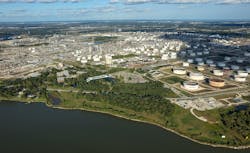ExxonMobil integrating Honeywell Carbon Capture technology to Gulf Coast Refining
Energy firm ExxonMobil has announced plans to deploy Honeywell’s carbon capture technology at its integrated complex in Baytown, Texas.
The technology, called CO2 Fractionation and Hydrogen Purification System, is expected to help ExxonMobil capture approximately 7 million tons of carbon dioxide (CO2) per year, which is equivalent to the annual emissions of 1.5 million automobiles.
According to ExxonMobil, it will also integrate a Honeywell UOP carbon capture technology into the design of its low-carbon hydrogen production facility to capture more than 982 percent of associated CO2 emissions. It plans to sequester and permanently store the captured CO2.
“ExxonMobil's investment in carbon capture technology shows our commitment to supporting customers in their decarbonization efforts and to reducing emissions at our own operations,” said Dan Ammann, President of ExxonMobil Low Carbon Solutions. “The scale of this project is expected to enable up to 30% of Scope 1 and 2 emissions from our Baytown facility by switching from natural gas as a fuel source to low-carbon hydrogen.”
At its Baytown integrated complex, ExxonMobil says it is planning to launch the world’s largest low-carbon hydrogen project in 2027-2028, with the capacity to produce around one billion cubic feet of low-carbon hydrogen per day. Sited on approximately 3,400 acres along the Houston Ship Channel, the Baytown ammonia and carbon capture facility is said to be home to the largest olefins plant in the U.S.
“The use of Honeywell’s technology enables ExxonMobil to reduce CO2 emissions at a large scale,” said Barry Glickman, Vice President and General Manager of Honeywell Sustainable Technology Solutions. “Our ready-now carbon capture technology works to decarbonize production processes and is effective because it can allow for significant emissions reduction that can play a major role in the energy transition.”
About the Author
EnergyTech Staff
Rod Walton is senior editor for EnergyTech.com. He has spent 17 years covering the energy industry as a newspaper and trade journalist.
Walton formerly was energy writer and business editor at the Tulsa World. Later, he spent six years covering the electricity power sector for Pennwell and Clarion Events. He joined Endeavor and EnergyTech in November 2021.
He can be reached at [email protected].
EnergyTech is focused on the mission critical and large-scale energy users and their sustainability and resiliency goals. These include the commercial and industrial sectors, as well as the military, universities, data centers and microgrids.
Many large-scale energy users such as Fortune 500 companies, and mission-critical users such as military bases, universities, healthcare facilities, public safety and data centers, shifting their energy priorities to reach net-zero carbon goals within the coming decades. These include plans for renewable energy power purchase agreements, but also on-site resiliency projects such as microgrids, combined heat and power, rooftop solar, energy storage, digitalization and building efficiency upgrades.
